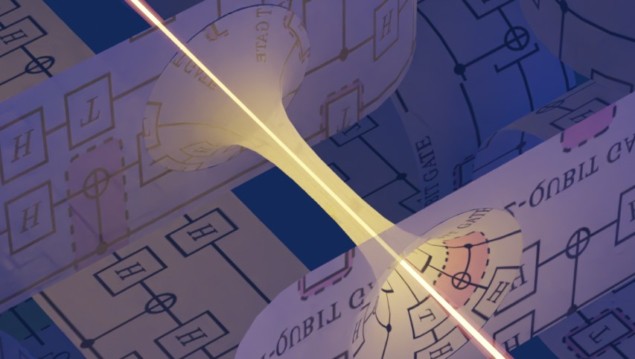30 Nov 2022 by Martijn Boerkamp

The equivalent to a wormhole in space–time has been created on a quantum processor. Researchers in the US used an advanced quantum teleportation protocol to open the wormhole and send quantum signals through it. By studying the dynamics of the transmitted quantum information, the team gained insights into gravitational dynamics. The experiment could be further developed to explore quantum gravity or string theory.
A wormhole is a bridge in space–time that connects two different locations. While wormholes are consistent with Albert Einstein’s general theory of relativity, they have not been observed by physicists. Unlike wormholes in science fiction, they are not traversable – meaning things cannot pass through them.
Although general relativity forbids travelling through a wormhole, it is theorized that exotic matter – matter with negative energy density and negative pressure – could open a wormhole and make it traversable. But these theories are difficult to test, even if one could create a wormhole in a lab.
Quantum teleportation
But physics has a trick up its sleeve – in the form of the quantum teleportation of information between two entangled particles. This process occurs instantaneously and therefore emulates the process of sending quantum information through a gravitational wormhole. In both cases, however, it is not possible to communicate faster than the speed of light because a subluminal signal is required to decode the information.
Quantum entanglement plays an important role in quantum computing, therefore a quantum processors is the ideal experimental device to explore the similarities between quantum teleportation and wormholes. In this scenario, quantum bits – or qubits – on the quantum processor are entangled with each other and teleportation is the equivalent of the qubit travelling through a wormhole.
Down the wormhole
Now Maria Spiropulu at Caltech, Daniel Jafferis at Harvard University and colleagues have done such an experiment. Their aim was to create a system that has the right ingredients for the type of teleportation that resembles a wormhole.
An important challenge that they first had to overcome is that it appeared that a large number of qubits would be needed to perform the experiment properly – many more qubits than are available in today’s quantum processors. To solve this problem, the researchers used machine learning to work out the minimum number of qubits required and how they should be coded to set up the quantum teleportation protocol. They discovered that they could create the wormhole dynamics on nine qubits with 164 two-qubit gates on a Google Sycamore quantum processor.
In their experiment the researchers showed that they could keep a wormhole open for a sufficient amount of time by applying negative energy shockwaves, which came in the form of special pulses of quantum fields. They then studied the dynamics of the quantum information that was sent through. Signals that travel through a wormhole experience a series of scrambling and unscrambling, with the quantum information exiting the wormhole intact.
Powerful testbed
On the Sycamore processor, they measured how much quantum information passed from one side to the other, when applying a negative versus a positive energy shockwave. And because only negative energy shockwaves would open up the wormhole, they found that only these shockwaves allowed signals to pass through. Overall, the information passing through the wormhole had key signatures of a traversable wormhole. This constitutes a step towards probing gravitational physics using quantum processors and could lead to the development of powerful testbeds to study ideas of string theory and quantum gravity.READ MOREQuantum complexity could solve a wormhole paradox
Juan Maldacena at the Institute for Advanced Study, in Princeton, US, who was not involved in the research, describes the work as an interesting first step in trying to create complex quantum systems that can have an emergent space–time description. He thinks the result is important because it is a demonstration that allows us to experimentally test some of the theoretical ideas about the connection between quantum mechanics and emergent space–time geometry. He says the research’s biggest achievement is that it has reproduced a kind of quantum teleportation that is inspired by gravitational problems.
Team member Daniel Jafferis believes that there are many additional protocols and new ideas to explore and he expects more “gravity experiments” to be performed by quantum computers in the future. He thinks that some of these will require much larger quantum computers or much deeper circuits, but that others are well-suited for near-term experimentation.
“One of the things we would like to do next is to realize somewhat larger systems and try to observe more detailed structure of the emergent wormholes and their gravitational dynamics”, he tells Physics World.
Edward Witten, also at the Institute for Advanced Study and not involved in this research, says that the authors have done a nice job of describing a simplified version of the protocol that could be realized experimentally. He calls this experiment – and the presumed improvements that may be possible – to be a “milestone” in developing control over microscopic quantum systems. He states that even though such an experiment can certainly not give the sort of information that comes from physics experiments such as LIGO or the LHC, success with such experiments can confirm the validity of quantum mechanics in a rather subtle situation and also confirm that the theory has been analysed correctly.
The research is described in Nature.

Leave a Reply